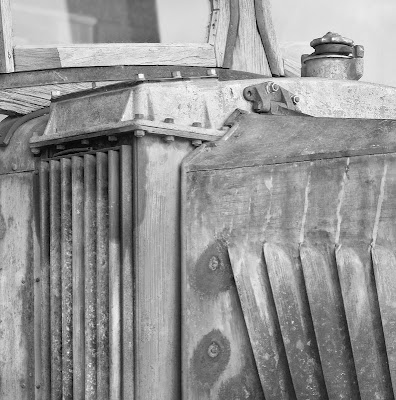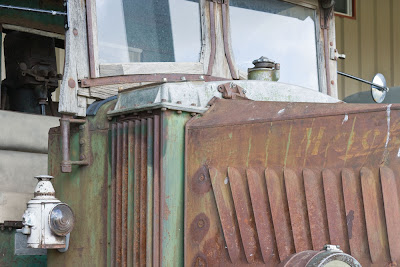A great deal of fun can be had, if you are inclined that way; in debating art and photography, art in photography, art vs. photography, art isn't photography (or more properly photography ain't art) and so on. The problem with such discussions (which often generate heated and passionate debate) is that they really don't serve any useful purpose than to entertain, said entertainment mostly supplied to those doing the debating, not the poor reader.
So the question today is - is there any role at all for discussing photography as art that can actually make a meaningful difference to the individual photographer? I think it can - I think that contemplating art in photography can make our images stronger and can increase the chance that images thereafter are more likely to have meaning for those viewing.
Although in my blog I have tended to write about the creative or artistic side of photography, seeing and composing and such, it could well be argued that these topics remain the purview of craft rather than art. That being the case, what can or should be said about the art in photography?
Without getting into a (meaningless) debate about what is art, it might be possible to discuss how one experiences art in general and then apply that to photography and usefully discuss ideas for making images with better artistic elements.
Let's take an imaginary trip to a painting gallery. There are some two dozen landscape paintings displayed, by a number of local artists. Prices are actually affordable so it's not inconceivable that if something really caught your attention, you could actually consider purchasing it for that spot over the sofa. There is no consistency in style (after all it's a group show of "landscapes", technique and interpretation up to the painter.
We make a quick tour around, suspecting as we do that local talent may be lacking and our expectations aren't terribly high. Still, you never know, and the greats were once unknown and so with at least the hope of seeing something interesting, we survey the works.
There are several pretty scenes which would not disgrace our living room, some that are just plain odd and a few which don't seem to display much skill, in colour or composition or whatever.
A couple of the images are just plain disturbing, and one image reminds you of some of your best hikes - odd because what it reminds you of is the smell of rotting leaves in the fall - almost like tea, and the sharpness of the cool yet sunny fall air. You can almost hear the rustle of leaves in the trees. Odd, because the image is semi abstract and clearly doesn't show a hell of a lot - so how could the artist possibly have put all that into his painting. Perhaps he didn't even know he'd done so. Maybe someone else seeing the painting gets an entirely different feeling from it.
It so happens that this is opening night and while most people are gathered round the wine and munchies, talking to each other, the artists are standing round the walls, just waiting for some interested person to talk to them. You find the painter of this semi abstract image apparently representing fall and start a conversation.
Rather than offer a leading question like "how did you get the rustle of the leaves into the painting", you ask the more open ended question of "what did you want me to see in this painting?".
Unlike some artists who have been "got to" by gallery owners and been taught to to talk "artspeak", this fellow is rather naive and gives quite straight forward answers. Turns out he didn't have an agenda. He feels interpretation is entirely up to the viewer and he can tell you that this evening he has already had several interpretations offered, each incompatible with all the others, and none having the least to do with the thoughts of the painter at the time.
You want more than this so and you press the artist to explain why he made this particular painting. He hesitantly explains that he was sitting on the toilet, looking out through the frosted bathroom window at leaves of a maple actually brushing up against the window, shifting somewhat in an apparent breeze. Obviously he has sat here on many occasions, but something makes him pay attention. It might be the light or the particular variation of fall colours (though they hadn't changed much in the last few days and only on that particular day had the urge struck to make a painting.
He suggests it might just be his mood on the day, a little wistful, a few days after his girl friend has gone on a trip to Europe. He was feeling restless and empty. Did he consciously plan to paint that - hell no, he'd only just thought of it when you asked the question, and the explanation wasn't likely any more accurate than the suggested interpretations offered by the other gallery goers.
You still aren't satisfied - there must have been a reason to not only pick up a brush but to select those colours, paint them in that particular way, with the composition chosen and painted in the style selected.
The artist stumbles on this, and finally, recognizing the failure of his answer, admits that "it just seemed right".
It's clear that there is no great existential "truth" in this image for the painter, and even learning of his frame of mind at the time doesn't really explain how you came to interpret the image the way you did, and it occurs to you that perhaps had your mood been different, you might have interpreted the image in an entirely different way.
You leave the gallery with some idea of the creative process and wonder how you can apply what you have learned in your own photography.
Lessons learned:
1) It isn't essential for a work of art to have a message, only that it be capable of interpretations, the latter being entirely personal to the viewer.
2) There needs to be a reason to take the picture, and thoughts of "it will sell well" aren't good enough. It has to be a reason that relates to the artist. In the case of the photographer, it probably isn't necessary to understand why, just enough that you thought something needed photographing, that it intrigued you in some way you aren't even aware of, or perhaps even the feeling of "gee, I can do something with that".
3) We have no trouble ascribing the term "artist" to a painter, but similar thoughts and drives and needs seem to happen to photographers, so why shouldn't we apply the term to photographers?
If we are willing to ascribe the term artist to at least some photographers, then to whom do we apply the term? Who clearly does or doesn't qualify and now does one decide? Does it matter if the photographer was on contract and being paid to produce the work? Well, most certainly almost all of the famous artists from Michelangelo to Rembrandt were most certainly on commission. Many modern artists have commissions from government agencies to work on a project, just as Edward Weston and Ansel Adams had Guggenheim Fellowships to explore projects. It's beginning to look as if there isn't a lot of difference between painters and photographers after all. Maybe photographers are artists after all, and perhaps even hobbyist photographers who see something interesting and photograph it and edit it are artists too, even if not terribly experienced, or talented ones. Just maybe there's a little bit of artist in all of us and we should stop worrying about whether we are being artful or not.
A lot can be learned from listening to great photographers speak about the motivations for their work. Sure a few, like Caponigro, couch their work in "artspeak" but the vast majority do not and their motivations and pathways seem not a lot different from ours.
I can highly recommend Edward Weston's Daybooks as useful reading to understand the mind of a great photographer. Attending workshops and conferences where you can be exposed to several great photographers can be helpful.
If nothing else, you are likely to learn that great photographers are human too, that their thought processes are typically similar to ours when out photographing - it's just that they have a better eye for the interesting, have more skill in composing and editing an image and perhaps most of all, are better at not bullshitting themselves into believing an image is "good enough" when your heart says no.
It is fascinating to look at proof sheets of the greats - that their proofs really don't look all that different from ours, except we didn't make that one image on the proof that really stands out compared to the rest. They knew they "hadn't got it yet" and kept striving till they did "get it" where we quit without perhaps even knowing that we could have gone further. They had the tools (mentally that is) and we didn't - therein lies the difference between the great and the good.
The difference between good and great isn't one of kind, but of degree, of effort, experience, skill, determination, and perhaps a recognition of a journey completed - "ahah, that's what I wanted".










































